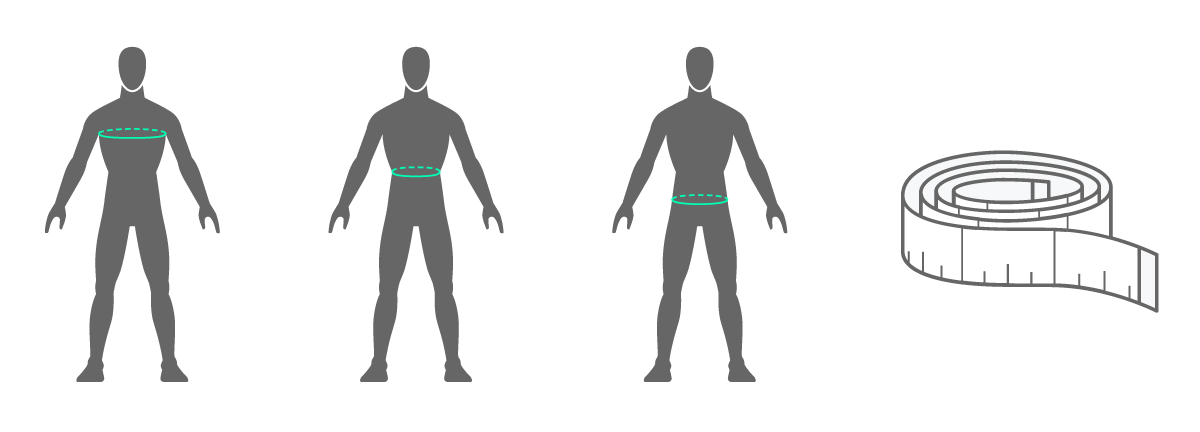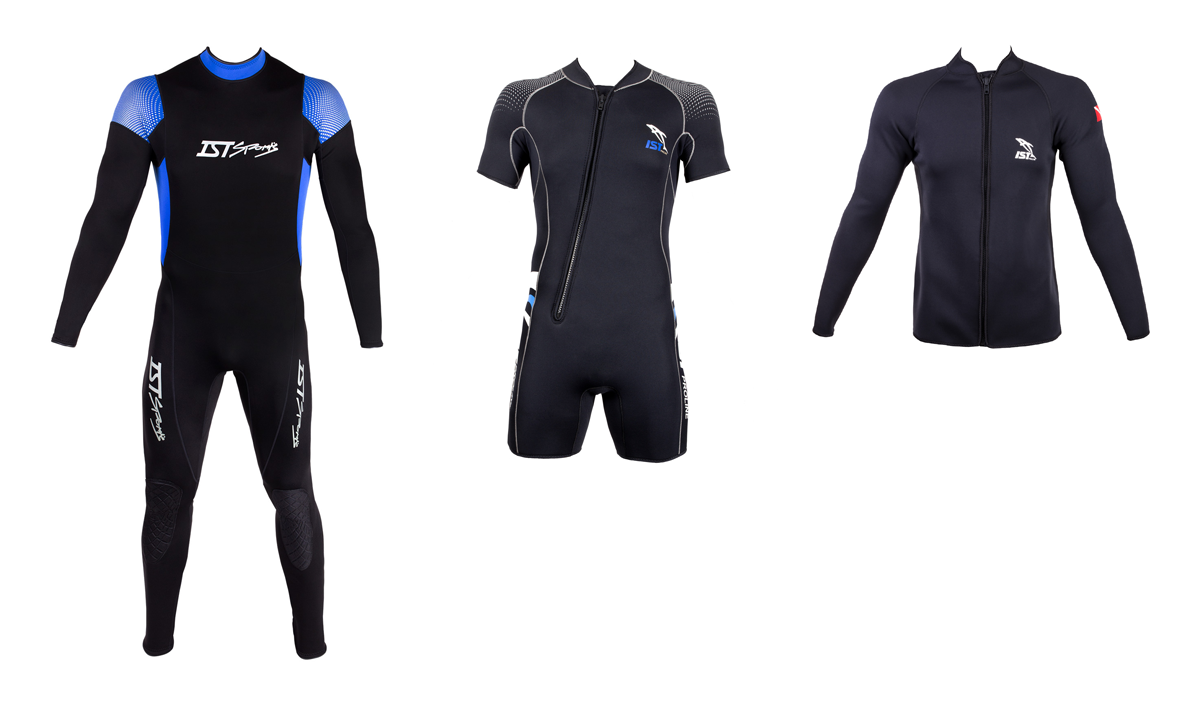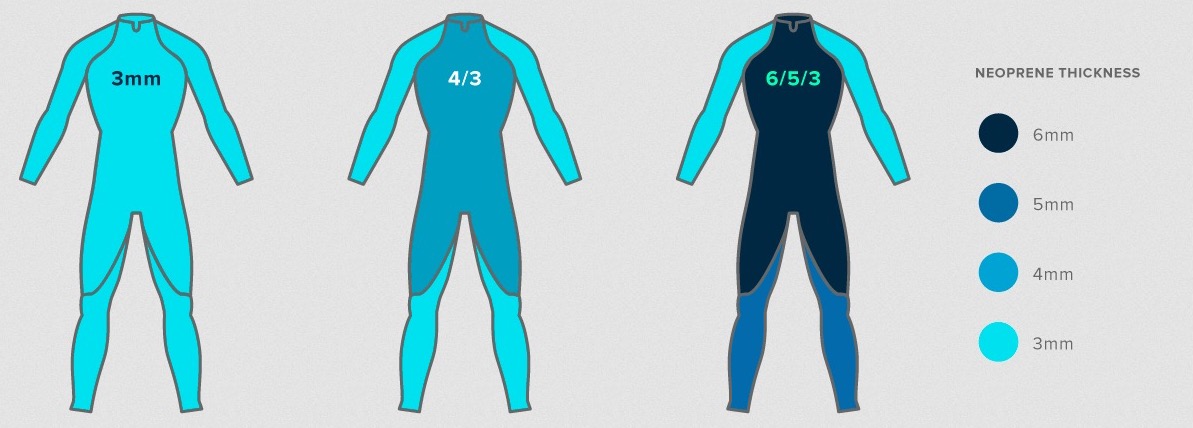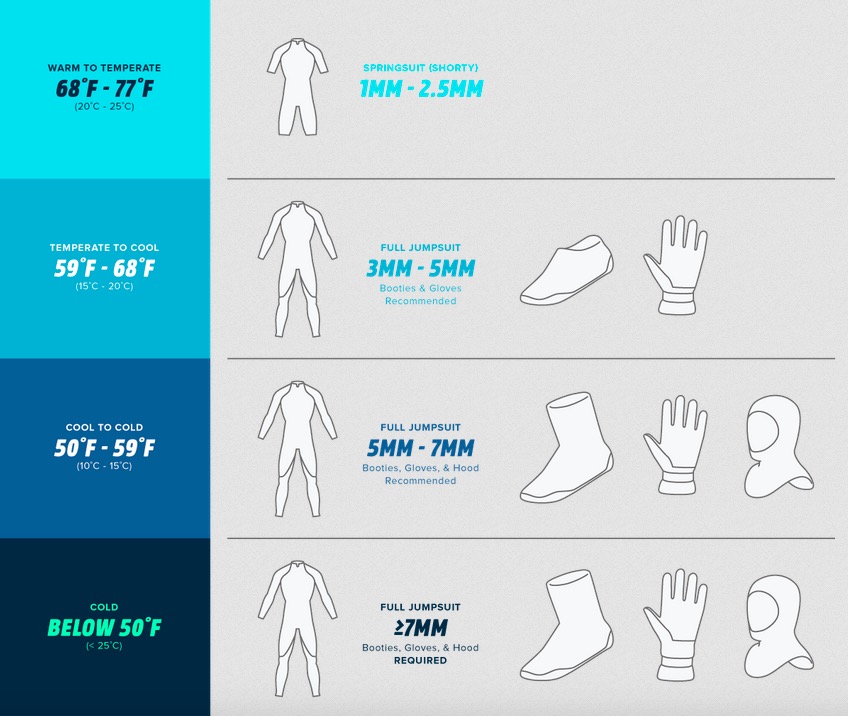If you live outside of the tropics and you plan to spend any extended amount of time outdoors and underwater, you’re going to need a wetsuit to help keep you warm, happy, and alive. We put together a wetsuit buying guide to help you learn what to look for, whether it’s your first one, or you’re already looking for your next one. A wetsuit is an investment, and the effort and time you put into choosing the right fit for you now, will reward you in the water with enjoyable and comfortable diving experiences for the foreseeable future. The key factors include:
- Getting a great fit
- Choosing the best cut and thickness
- Important construction details
- Head, hands, and feet
How Do Wetsuits Work?
Wetsuits are designed to keep a body warm for extended periods of time in cold water, and in the most extreme cases, help prevent hypothermia. A large volume of cold water can absorb heat from your body much quicker than air, so it’s important to get the right equipment.
The neoprene wetsuit as we know it today was originally invented in 1952 by Hugh Bradner, a physicist, UC Berkeley professor, and life-long diving enthusiast. Wetsuits are typically made of neoprene, a soft, flexible, sponge-like, closed-cell, foam rubber material full of tiny densely packed air bubbles.
Neoprene is an insulator. It resists the transfer of heat, and acts as a barrier that prevents heat from escaping your body from contact with the large volume of water outside the suit (heat loss by conduction). Heat tends to go from warmer objects to colder objects, toward achieving an equilibrium, where both objects have the same resulting temperature. An ocean, lake, pond, or swimming pool can hold a lot more heat than your body can make over time. Without a wetsuit, your body would gradually approach the same temperature as the water (not good). The little trapped air bubbles in the neoprene are responsible for its high resistance to heat loss. Neoprene rubber conducts heat 10x slower than water, and still air conducts heat 20x slower than water (moving air is a whole other story though).
The less water allowed in the suit, the better. Contrary to popular belief, having water in your wetsuit isn’t what makes it work. While a thin layer of water warmed by the body can help insulate you, the neoprene rubber and the tiny trapped air pockets do the bulk of the work. No suit will ever be completely air-tight or water-tight, so water will inevitably be present in a small enough quantity that your body can warm it.
Getting a Great Fit
The first thing you’ll need to do is take your 3 key measurements: chest, waist, and hips. Pay attention to the manufacturer’s sizing chart. If you don’t know your measurements, you’ll need a tailor’s or sewing measuring tape to measure the circumference of your chest at its widest point, the circumference of your natural waist, and also of your hips. It’s easiest to do this standing in front of a mirror in your undies. For more detail on how to take your measurements, check out this guide.

THE ESSENTIAL MEASUREMENTS (FROM LEFT TO RIGHT): CHEST CIRCUMFERENCE, WAIST CIRCUMFERENCE, HIP CIRCUMFERENCE.
Wetsuits are meant to fit tightly, but you should still be able to breathe easily, and you shouldn’t be losing circulation to your hands or feet. On the flipside, you want to make sure there’s not excess material or folds on your back or your limbs. A loose-fitting wetsuit will allow too much water to flow in and out, causing you to quickly lose heat (heat loss by convection). That makes it hard to stay comfortably warm on a dive of any duration. Lots of water moving in and out of your wetsuit is called flushing, and a little is called seepage. Both are bad for the quality of your dive and neither sound remotely sexy. They should be avoided and prevented, and that’s accomplished first and best by getting the right fit.
Choosing Cut & Thickness
Wetsuits are available in a range of styles (or cuts), and thicknesses. Determining the right cut and thickness depends on 4 factors that affect temperature and mobility:
- the conditions where you’ll be active
- your body’s tolerance for cold
- the range of motion required for the activity
- how active you’ll be
Generally, colder seasons and conditions require more body coverage, and thicker material, while warmer seasons and conditions require less coverage, and thinner material. Your tolerance for cold will also be an important factor in choosing the right suit.
Neoprene can be quite stiff, especially when it’s thick and stuck to your skin. That can limit your ability to make big movements easily or comfortably. Surfing, kayaking, or triathlons require more flexibility and thinner material especially around the shoulders and joints for easier mobility. Activity also warms the body. A more active sport may also allow you to wear a lighter suit. If you can tolerate the cold better than the average person, you might also be able to wear a thinner suit to gain improved mobility in the water. Scuba diving, on the other hand, typically involves slower and smaller movements in deeper colder water. Thicker material and more coverage would make more sense in this case.
Typical cuts

Wetsuits are usually available as a single-piece or top in different arm and leg lengths. A full jumpsuit covers up the whole body up to the base of the neck and out over the wrists and ankles. This kind of cut is best for cold conditions. A springsuit or shorty covers a little less, reaching to just above the elbows and just above the knees. This is better for warmer conditions. You can also find neoprene jackets and separate tops, and less commonly in an overall style sleeveless cut that fully covers the legs down to the ankle.
PICTURED LEFT TO RIGHT: FULL JUMPSUIT, SPRINGSUIT (SHORTY), NEOPRENE JACKET
Neoprene thickness
Thicker neoprene typically provides better protection from the cold than thinner neoprene (putting more tiny air bubbles between you and the water. When you’re shopping for a wetsuit, you’ll often see a set of numbers that look like fractions. They’re indicators of the mm thickness of different parts of a wetsuit.
- A single number means the whole suit is made out of the same thickness of neoprene.
- Two numbers first show the thickness of the torso, and then a different thickness for the limbs. For instance, a 4/3 is made of 4mm thick neoprene to cover the torso, and 3mm neoprene to cover the limbs. This is usually done to provide more insulation for the core without sacrificing as much mobility, or vice versa.
- Three numbers mean the arms are also made with another thickness of neoprene different from the legs or torso. So a 6/5/3 is made of 6mm thick neoprene to cover the torso, 5mm on the legs, and 3mm on the arms.

SOME EXAMPLES THAT BREAK DOWN WETSUIT NUMBERING
Here are some general recommendations that you can base your final decision on in terms of cut and thickness. Remember take into consideration your own cold tolerance, and your expected level of activity as well:

A CHART OF BASIC RECOMMENDATIONS. WEAR THICKER MATERIALS AND INCREASE COVER IN COLDER CONDITIONS.
Important Construction Details
Construction and design details in how your wetsuit is made can incrementally improve its effectiveness, and the quality and comfort of your dive, as well as the lifespan of your wetsuit. A lot of little improvements can add up to big gains. Here are a few things to look for:
Seam types
The 4 most common types of seams are:

- Overlock – the least expensive kind of stitching, and also the least flexible, with poor water-tight qualities. Overlock stitching creates a raised bump along the seam that can rub and feel uncomfortable to wear. You may see this on the most inexpensive wetsuits. Avoid this if you can.
- Flat-Lock – an inexpensive kind of stitching that’s flexible and durable, but not water-tight. You’ll see this mostly on thinner wetsuits. The stitching penetrates both sides of the material and makes lots of little holes that can lead to a bit of seepage. Most common on entry-level wetsuits.
- Glue and Blind-Stitched – found on higher end wetsuits, the neoprene is butted together and the seam is glued first and then stitched together from only one side of the wetsuit. Since the stitching doesn’t penetrate both sides of the neoprene, this stitch is very water-tight, and also more flexible. On thicker wetsuits, you may see blind stitching on both the inside and outside.
- Welded Seams – seams are butted together and glued then covered with a heat-bonded rubber tape on either one side or both. It can be done with or without stitching the neoprene first. Flexible and water-tight. Goes by many names. It’s durable, flexible, and usually found only on high-end wetsuits. You may find only a few seams are taped/welded for added durability and protection against seepage, in just a few key areas, or up to a fully taped wetsuit. It’s usually on the inside, but sometimes found on the outside of a wetsuit too.
Zippers
You’ll find 3 main kinds of zippers on wetsuits:
- Back zipper – the most commonly available kind, and the easiest to put on. More common on surfing wetsuits because chest zippers get between you and the board and may be uncomfortable. Has a long leash (like a lanyard attached to the zipper).
- Front zipper – does a better job reducing flushing at the neckline, but harder to put on. This is traditionally more common on diving wetsuits, because it doesn’t get between you and your tank.
- Zipperless – the least common and only available on wetsuits made with very stretchy types of neoprene material. This tends to be a very expensive material, and the extra flexibility isn’t really worth the added cost to a diver.
Neckline
You’ll see a range of collar types on wetsuits: banana collar (commonly on shorties), mandarin collar (on full suits), mock-neck, and turtle-neck. In order from warmest conditions to coldest. Typically, colder conditions will require more cover.
Knee pads
Prolong the life of the wetsuit. Often a thicker material or coating applied to the knee area. This could save you some money in the long-term.
Cuffs
Look for zippers at the wrists and ankles on thicker wetsuits. This makes them easier to put on and take off. Thinner wetsuits tend to stretch more and won’t usually need or have zippers at the cuffs.
Lining
- Smooth Skin Neoprene – This is neoprene that has no lining on it. Neoprene is usually cast as a block and then sliced like bread. Think of smooth skin neoprene as the heel ends of the loaf. This tends to be very grippy, creating an excellent seal, often reserved for cuffs and collars. It’s otherwise very hard to put on if used in sleeves and legs.
- Neoprene I – One side of the neoprene is lined with nylon fabric. The nylon side slides on better than bare neoprene when putting your wetsuit on, or when taking it off.
- Neoprene II – Two layers of nylon facing, one on each side.
- Plush – Terry loop lining that goes on smoother than nylon and is more absorbent. Supposedly this keeps you a little warmer by reducing the water flow inside the suit, as it traps water in the suit better. But it could just be because it’s a little thicker and insulates a little better than a thin layer of nylon.
Chest pad
Added protection to prolong the life of your wetsuit. You don’t need this unless you’re planning to go spearfishing. A chest pad helps to load a spear gun more easily.
Insulating Extremities: Head, Hands, and Feet
In more severe temperatures, you’ll most likely need to shield more parts of the body from cold than a wetsuit can cover alone. Neoprene hoods, booties, and gloves help to cover and keep warm all the areas left exposed by a typical full suit. Without them, cold hands, face, and feet can become extremely uncomfortable or painful. That could ruin an otherwise positive diving experience. While essential in cold water, these accessories are even useful in warmer waters, helping to prolong dive time, slowing the loss of heat to the water.
Hoods
Check the seal around the face. Better seals usually are made with smooth skin neoprene. That means there’s no nylon fabric facing on the inside. Just like with a wetsuit, it’s best to try these on in-person to ensure a good and comfortable fit.
Booties
- Toe Caps and Heel Caps – Rubber protective layers that prolong the lifespan of your booties.
- Fin Strap Cleat – Look for a bump on the heel to help secure your fin strap to your booties and keep them from slipping off.
- Cut – Lower cuts are also typically made of thinner neoprene (around 3mm), and higher cut booties are typically thicker (5mm). Lower cuts are usually meant only to protect the bottoms of feet for shore dives or rocky beaches and are sometimes called socks. Higher cuts are typically designed to protect your feet from cold (and also provide protection to the bottoms of your feet).
- Soles – Usually vulcanized rubber which is good and grippy. A few divers we know prefer felt soles as for their non-slip properties. This really comes down to personal preference. Watch out for booties marketed with sneaker soles. They look nicer and make a fashion statement, but tend to not grip as well as traditional rubber soled booties (more slippery), and also tend to require a wider foot-pocket in your fins. That means if you already own your own fins, sneaker soled booties probably won’t fit, and you’d end up needing to buy new fins with a larger foot pocket for your slippery fancy-looking new booties.
Gloves
There are lots of unique choices when it comes to gloves. Openable thumbs and index fingers enable fine motor skills underwater (mostly photography and spear fishing). Kevlar prolongs product life, and also protects from punctures and bites and provides added grip. Thicker gloves tend to be longer and cover more of your wrist and forearm. Longer gloves should have a velcro strap around the forearm to secure it in place. That allows for a wider opening that makes them easier to put on and take off.
Conclusion
A lot goes into deciding which wetsuit to buy, but at least now, you’re better equipped and more knowledgeable to buy your first (or next) wetsuit. Remember to have your measurements on-hand and consider the type of activity and the temperature range you’ll be diving in most often. If you’re looking for a good dependable wetsuit for diving, why not check out IST’s acclaimed WS-80, rated a Best Buy by Scuba Diving Magazine’s Scuba Lab.
If buying your own wetsuit still seems too complicated or expensive, or you just aren’t ready to take the plunge yet, don’t let that stop you from diving. You can rent first, visit your local diving shop to try one on in-person, or there’s always this:

